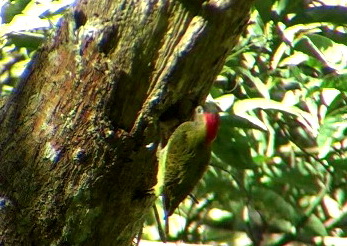Golden-olive Woodpecker
From Wikipedia, the free encyclopedia
[Photo] Piculus rubiginosus Golden-olive Woodpecker. A female enlarging its nest-hole. Peru.
The Golden-olive Woodpecker, Colaptes rubiginosus, is a resident breeding bird from Mexico south and east to Guyana, northwest Argentina, Trinidad and Tobago. It was formerly placed in the genus Piculus (Benz et al., 2006).
The habitat of this woodpecker is forests, more open woodland, and cultivation. It is most common in the mountains. Two or three white eggs are laid in a nest hole in a tree and incubated by both sexes. The young are fed by regurgitation.
The Golden-olive Woodpecker is 22 cm long and weighs 68g. Adults are mainly golden olive above with some barring on the tail. The forecrown is grey, and the hindcrown red. The face is yellow-white and the underparts are barred black and yellowish. The bill is black. Adult males have a red moustachial strip which is lacking in the female.
Due to its habitat - mainly montane forest, separated by large rivers - it has evolved into about 20 subspecies. P. r. tobagensis from Tobago is larger and heavier-billed than the Trinidadian P. r. trinitatis. Some of the South American races have only very narrow yellow barring on the underparts, and Andean birds show a pale eyering.
Golden-olive Woodpeckers mainly eat insects, including ants and beetle larvae, with some fruit and berries. The call of this bird is a loud wheep.
http://en.wikipedia.org/wiki/Golden-olive_Woodpecker
| The text in this page is based on the copyrighted Wikipedia article shown in above URL. It is used under the GNU Free Documentation License. You may redistribute it, verbatim or modified, providing that you comply with the terms of the GFDL. |
|

